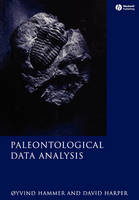
Paleontological Data Analysis
Blackwell Publishing Ltd (Verlag)
978-1-4051-1544-5 (ISBN)
- Titel erscheint in neuer Auflage
- Artikel merken
It is an invaluable tool for all students and researchers involved in quantitative paleontology.
Dr Oyvind Hammer is currently a Researcher in Paleontology at the Geological Museum in Oslo, and in Geobiology at the research center "Physics of Geological Processes". In addition to a number of research publications, he is the author of the popular data-analysis software PAST. David Harper is a leading expert on fossil brachiopods and numerical methods in palaeontology. He is Professor of Palaeontology in the University of Copenhagen, where he is currently Head of Geology in the Natural History Museum of Denmark. He has published over 10 books and monographs, including a couple of influential textbooks, as well as over 250 scientific articles and, together with Oyvind Hammer, the widely-used software package PAST. His time is divided between collection management, exhibition work, research and some teaching.
Preface. Acknowledgments. 1 Introduction. 1.1 The nature of paleontological data. 1.2 Advantages and pitfalls of paleontological data analysis. 1.3 Software. 2 Basic statistical methods. 2.1 Introduction. 2.2 Statistical distributions. 2.3 Shapiro-Wilk test for normal distribution. 2.4 F test for equality of variances. 2.5 Student's t test and Welch test for equality of means. 2.6 Mann-Whitney U test for equality of medians. 2.7 Kolmogorov-Smirnov test for equality of distributions. 2.8 Permutation and resampling. 2.9 One-way ANOVA. 2.10 Kruskal-Wallis test. 2.11 Linear correlation. 2.12 Non-parametric tests for correlation. 2.13 Linear regression. 2.14 Reduced major axis regression. 2.15 Nonlinear curve fitting. 2.16 Chi-square test. 3 Introduction to multivariate data analysis. 3.1 Approaches to multivariate data analysis. 3.2 Multivariate distributions. 3.3 Parametric multivariate tests. 3.4 Non-parametric multivariate tests. 3.5 Hierarchical cluster analysis. 3.5 K-means cluster analysis. 4 Morphometrics. 4.1 Introduction. 4.2 The allometric equation. 4.3 Principal components analysis (PCA). 4.4 Multivariate allometry. 4.5 Discriminant analysis for two groups. 4.6 Canonical variate analysis (CVA). 4.7 MANOVA. 4.8 Fourier shape analysis. 4.9 Elliptic Fourier analysis. 4.10 Eigenshape analysis. 4.11 Landmarks and size measures. 4.12 Procrustean fitting. 4.13 PCA of landmark data. 4.14 Thin-plate spline deformations. 4.15 Principal and partial warps. 4.16 Relative warps. 4.17 Regression of partial warp scores. 4.18 Disparity measures. 4.19 Point distribution statistics. 4.20 Directional statistics. Case study: The ontogeny of a Silurian trilobite. 5 Phylogenetic analysis. 5.1 Introduction. 5.2 Characters. 5.3 Parsimony analysis. 5.4 Character state reconstruction. 5.5 Evaluation of characters and tree topologies. 5.6 Consensus trees. 5.7 Consistency index. 5.8 Retention index. 5.9 Bootstrapping. 5.10 Bremer support. 5.11 Stratigraphical congruency indices. 5.12 Phylogenetic analysis with Maximum Likelihood. Case study: The systematics of heterosporous ferns. 6 Paleobiogeography and paleoecology. 6.1 Introduction. 6.2 Diversity indices. 6.3 Taxonomic distinctness. 6.4 Comparison of diversity indices. 6.5 Abundance models. 6.6 Rarefaction. 6.7 Diversity curves. 6.8 Size-frequency and survivorship curves. 6.9 Association similarity indices for presence/absence data. 6.10 Association similarity indices for abundance data. 6.11 ANOSIM and NPMANOVA. 6.12 Correspondence analysis. 6.13 Principal Coordinates analysis (PCO). 6.14 Non-metric Multidimensional Scaling (NMDS). 6.15 Seriation. Case study: Ashgill brachiopod paleocommunities from East China. 7 Time series analysis. 7.1 Introduction. 7.2 Spectral analysis. 7.3 Autocorrelation. 7.4 Cross-correlation. 7.5 Wavelet analysis. 7.6 Smoothing and filtering. 7.7 Runs test. Case study: Sepkoski's generic diversity curve for the Phanerozoic. 8 Quantitative biostratigraphy. 8.1 Introduction. 8.2 Parametric confidence intervals on stratigraphic ranges. 8.3 Non-parametric confidence intervals on stratigraphic ranges. 8.4 Graphic correlation. 8.5 Constrained optimisation. 8.6 Ranking and scaling. 8.7 Unitary Associations. 8.8 Biostratigraphy by ordination. 8.9 What is the best method for quantitative biostratigraphy?. Appendix A: Plotting techniques. Appendix B: Mathematical concepts and notation. References. Index
| Erscheint lt. Verlag | 1.11.2005 |
|---|---|
| Zusatzinfo | 495 |
| Verlagsort | Oxford |
| Sprache | englisch |
| Maße | 178 x 247 mm |
| Gewicht | 649 g |
| Themenwelt | Naturwissenschaften ► Geowissenschaften ► Geologie |
| Naturwissenschaften ► Geowissenschaften ► Mineralogie / Paläontologie | |
| ISBN-10 | 1-4051-1544-0 / 1405115440 |
| ISBN-13 | 978-1-4051-1544-5 / 9781405115445 |
| Zustand | Neuware |
| Informationen gemäß Produktsicherheitsverordnung (GPSR) | |
| Haben Sie eine Frage zum Produkt? |
aus dem Bereich



